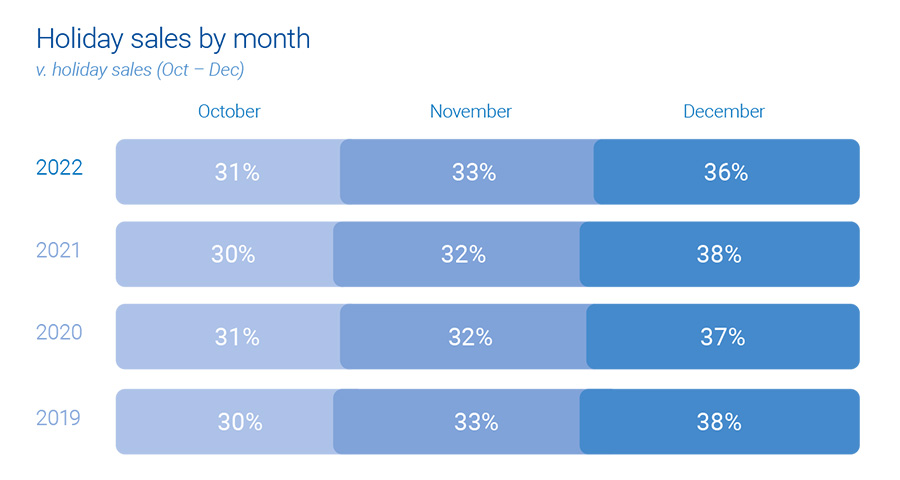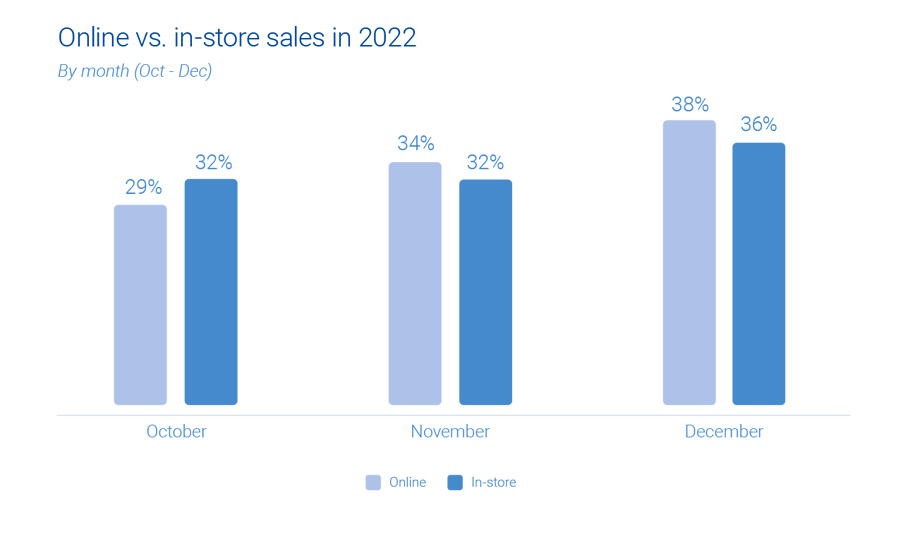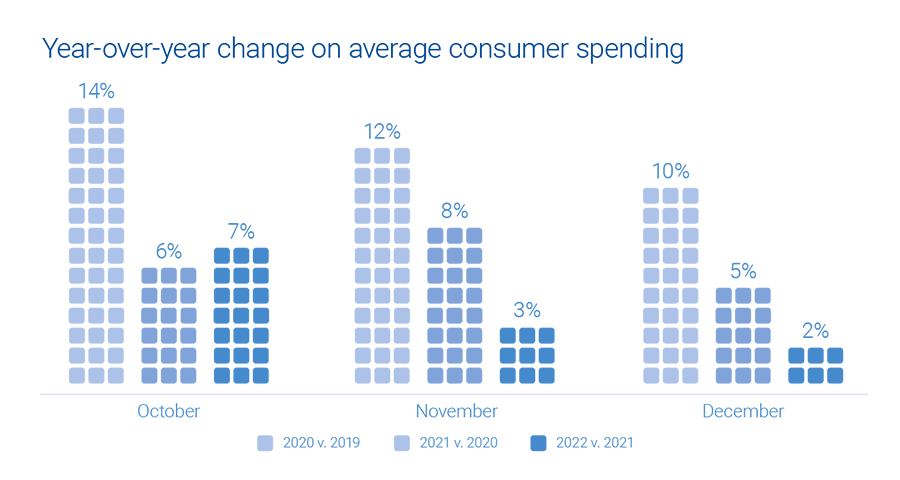
The holiday season is just around the corner, and retailers and marketers are gearing up for the busiest shopping period of the year. It’s crucial to understand how consumer behavior is evolving and what emerging trends to expect. Experian’s 2023 Holiday spending trends and insights report analyzes recent trends, consumer spending habits, and anticipates what’s to come in 2023 to help you deliver a top-notch shopping experience this holiday season.
In this blog post, we’ll cover three key insights from our report.
1. Consumers are shopping earlier
It’s no secret that December has always been the go-to month for consumers when it comes to holiday spending. However, holiday shopping now starts earlier, particularly with online sales.

This can be attributed to a surge in promotions and deals, enticing shoppers to open their wallets ahead of time, giving a significant boost to holiday sales. Notably, Cyber Week sales have proven to be an influential factor, accounting for 8% of total consumer holiday spending.
Experian tip
Reach the right shoppers with your promotions with sell-side targeting. This powerful approach gives you control over where your ads are placed while ensuring maximum visibility through direct connections with publishers. Whether on mobile, web, or CTV, this seamless ad experience will engage your audience effectively.
2. Online sales are on the rise
The popularity of online holiday sales is continuously growing, surpassing in-store shopping. There has been a consistent 1% year-over-year increase in online sales, while in-store sales have seen a 1% decrease.
“It’s easier for consumers to comparison shop for large ticket items online that they might find at a mass retailer or office supply store. Consumers prefer to have larger, bulkier items shipped directly to their home for minimal cost. By shopping online, consumers can save time since they don’t need to wait in checkout lines.”
Anna Liparoto, Sr. Account Executive, Retail & CPG

Although online sales currently make up only one-third of all holiday shopping, there is immense potential for further expansion. Mass retailers and office, electronics, and games industries particularly excel in online holiday sales. While in-store purchases remain the primary choice for holiday shoppers, consumer online and offline activities intersect before the final purchase.
Experian tip
Take advantage of the surge in online shopping by diversifying your marketing channels. An agnostic identity graph can bring together device and media data, capturing valuable user insights. By gaining a holistic view of your target audience, you’ll be able to optimize your ad spend and allocate resources effectively, ultimately boosting your return on investment.
“Omnichannel targeting during the upcoming holiday season will continue to prove to be the best way to reach scale and maximize ROI across all marketing channels.”
Joe LigÉ, Head of Enterprise Demand Partnerships
3. 2023 holiday spending will be on par with 2022
During the holiday season in 2022, consumer spending showed an anticipated increase, although the growth rate was slightly lower compared to previous years. October saw a surge in average consumer spending, indicating a swift response to early discounts and promotions offered by retailers.

As the holiday season progressed, holiday spending gradually slowed down and reached a level similar to that of the previous year. Overall, there was a modest 2% growth. Looking into the future, if economic conditions remain stable in the second half of 2023, we can expect holiday spending to align with the figures from last year.
Experian tip
To truly maximize impact, consider data enrichment. By diving deeper into your target audience’s preferences and behaviors, you can better tailor your strategies and seamlessly integrate the enriched data across various channels. This allows you to unlock the true potential of your ad inventory, creating more meaningful connections with your audience.
Download our 2024 report
Get ready for the holiday shopping season with Experian’s 2024 Holiday spending trends and insights report. Inside you’ll find:
- Analysis of past trends and what they mean for 2024
- Exclusive predictions for the upcoming holiday season
- The top audiences to activate this holiday season
To access to all of our predictions for this year’s holiday shopping season, download our 2024 Holiday spending trends and insights report today.
Latest posts

Partnership leverages industry-leading Tapad Device Graph™ for more effective video marketing across all connected devices NEW YORK, April 11, 2017 /PRNewswire/ – Tapad, a part of Experian, the leading provider of privacy-safe, cross-device marketing technology solutions, has announced its partnership with Innovid, the world's leading video marketing platform. This integration enables Innovid to bring cross-device personalization and a more unified viewer experience to its video marketing clients including Bank of America, L'Oréal, Microsoft and Procter & Gamble. Innovid's proprietary technology is the only platform optimized for video, enabling marketers to thrive in an ever-changing digital television landscape. Since its launch last year, Innovid's Marketing Cloud Suite has helped marketers increase message relevance and the opportunity to drive conversions, retention and acquisition through video personalization. By leveraging the Tapad Device GraphTM, Innovid's marketers can now benefit from the ability to drive consistent, personalized user experiences across all devices, creating more impactful connections with consumers and increasing ROI. "Personalization is a must for every data-driven marketer and really needs to happen across all devices to ensure a unified customer journey," says Ronnie Lavi, SVP of product at Innovid. "At Innovid, we recognize one size does not fit all when it comes to video. As an open platform, we are always looking to add best-of-breed capabilities through integrations and partnerships, and we've chosen Tapad because of its superior cross-device expertise." "Innovid has long paved the way for effective personalization in the video marketing space," says Pierre Martensson, GM of Tapad's data division. "As video continues to gain popularity across digital formats, we're excited to see how our technology empowers Innovid to bring that renowned personalization to more customers across all of their devices." Contact us today!

Tracey Scheppach's new marketing and media practice leverages Tapad's device-level data to help clients achieve "marketing nirvana" NEW YORK and CHICAGO, April 5, 2017 /PRNewswire/ — Today, Tapad, now part of Experian, is the leading provider of unified, cross-screen marketing technology solutions, and Matter More, a next generation marketing and media practice with deep experience in the advanced TV space, announced a strategic partnership to bring together world class digital data and audience development expertise to help marketers improve how they connect with consumers. As consumer behavior continues to expand across multiple devices, today's marketers need robust, comprehensive data solutions to accurately engage the people who matter most to their brands. At the same time, the TV industry has reached an advertising tipping point, capitalizing on the power of device-level data. "Achieving unduplicated reach and frequency across all channels with true addressability, and the ability to measure outcomes, is marketing nirvana," says Tracey Scheppach, CEO and co-founder of Matter More, a new agency built for the modern age. "The best opportunity to deliver 'marketing nirvana,' at scale, is by partnering with Tapad and using their world-class Device Graph to help our clients simply matter more to the people they care about most." "By leveraging our access to rich TV data, we can now measure the actual performance of media across channels," says Marshall Wong, SVP, TV for Tapad. Tapad's proprietary Device Graph™ unifies consumer behavior data across all devices, uncovering the interests, passions and behaviors of the audiences who matter most. As with any data solution, privacy, transparency and trust are crucial to bringing marketers a solid offering that delivers results. "Tapad is excited to partner with Matter More to tap into their knowledge base and experience working with some of the largest brands on TV today," says Kate O'Loughlin, SVP and GM of Tapad's media division. "The time has come to truly unleash the power of device-level data at scale." Contact us today

Verizon announced that they will be closing down their email business and migrating users to AOL over the next few months. With such an impending deadline it is important for email marketers to take action and consider the following steps to keep valuable email subscribers. Create a separate segment of all Verizon email addresses in your email automation platform. This will give insight into the size and ratio of this segment compared to your overall subscribers and helps you determine your strategy on acquiring their new email address. In your email campaigns make sure to use direct language in the subject line, the pre-header and header banner requesting that users update their email address either in a preference center or for them to create a new account If possible, make sure to link both the Verizon and new email address in your data-set to ensure that they are not treated as new when receiving future communication. As part of your email campaign strategy, be sure to target those who have not yet opened the email. We recommend sending two follow up emails using the previously created banners, and altering the subject line to encourage subscribers to take action. It is important to note that Verizon service users have been advised that they will keep their @verizon.net email domain if they switch over to AOL. If the user does not opt-in to the AOL service, then their email will be shut down and will subsequently bounce – if this happens then these should be removed from your dataset accordingly. For more information check out Verizon’s website here. If you are a client and have additional questions, please contact your manager or email us directly.